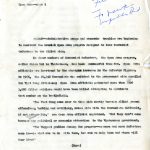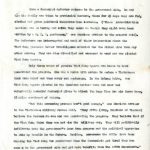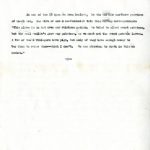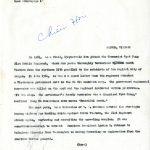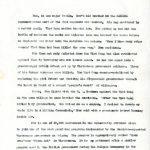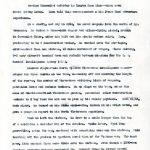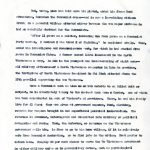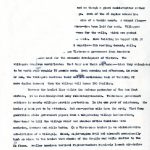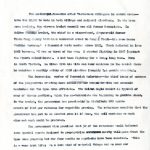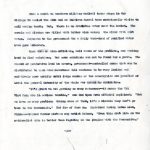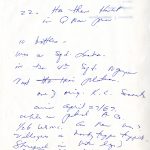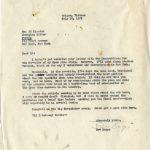1967, April 26, “Open Arms Program”
Beverly Ann Deepe
64A Hong Thap Tu
Saigon, Vietnam
April 26, 1967
Open Arms–page 1 File CH to nswk — unpublished.
SAIGON–Administrative snags and economic troubles are beginning to confront the crucial Open Arms program designed to lure Communist defectors to the Allied side.
In sheer numbers of Communist defectors, the Open Arms program, called Cheiu Hoi in Vietnamese, has been successful thus far. Open Arms officials are heartened by the steadyin increase in the defector figures. In 1966, the 20,242 Communists who switched to the government side equalled two Viet Cong divisions; Open Arms officials estimated more than 3000 3,000 Allied soldiers would have been killed attemting to eliminate that number on the battlefield.
The Viet Cong come over to this side mostly because Allied ground offensives, bombing and artillery, makes life with the Communists difficult, if not unbearable,” one Open ARms official explained. “But they don’t come because of any political or economic attraction to the Vietnamese government.
The biggest problem facing the program–as more and more defectors come in–is what can we do with them, how can we help them and where will they live?”
(More)
Deepe
Open Arms–page 2
Once a Communist defector returns to the government side, he and hjs his family are taken to provincial centers, where for 45 days they are fed, clothed and given political indoctrination lectures. (“These indoctrination sessions are so boring and naive they sound as though they might have been written by a M. I. T. professor,” one American advisor to the program said). The defectors are interrogated and much of their information about the Viet Cong produces better intelligence material for the Allied side than any other source. They are also classified and screened to weed out any planted Viet Cong agents.
Only three cases of genuine Viet Cong agents are known to have penetrated the program. One was a woman with orders to seduce a Vietnamese Open ARms cheif and then carry out espionage. In the Mekong Delta, two Viet Cong agents planted in the Open Arms centers were won over and volu7ntarily revealed Communist plans to attack the huge Bien Hoa air force base, 18 miles northwest of Saigon.
But this screening process isn’t good enough,” one American advisor to the Vietnamese military forces said. “They ARVNs (Army, Republic of Vietnam) believe the Communists can and are penetrating the program. They believe that if the Viet Cong think the can not win the military war, they will politically infiltrate into the government’s Open Arms program and the political apparatus to stir up trouble in the future. Besides, governmen the ARVNs have been chasing the Viet Cong for years–and when the Communists get tired they can come o to the government side and get more benefits than the ARVNs dependents.”
(More)
Deepe
Open Arms–page 3
While in the Open Arms centers, the defectors–or returnees as the Vietnamese government calls them–are supposed to recieve 24 piastres (roughly 20 cents) a day for food, 500 piastres ($4.50) for two suits of clothing and rewards for weapons brought into the government side (the equaveltn of $7 for a pistol and up to $170 for a lethal .57mm recoilless rifle).
But, in some provinces, the returnees complained to Open Arms officials that they were not recievinggiving them their clothing allowance. In other cases, Vietnamese officials had made a contract with a local tailor to get a kick-back and to give the returnees less than their money’s worth in clothing, reliable sources reported. In other cases, returnees promised wages for ramingmmn helping with the construction of Open Arms buildings complained to this correspondent they had not been paid. When a Vietnamese government official wasx confronted with this, he simply forced several unhappy returnees to sign receipts they had been paid–and then fired them from their construction jobs and transferred them to an already over-crowded remote provincial center.
American officials, infuriated with this failure of the Vietnamese government officials to fulfill their promise to the returnees, have attempted to get the hand-ful of corrupt officials removed. But, the most bothersome ones are seldome removed, American sources said.
It’s always the same story,” one American advisor explained. “The corrupt “Vietnamese civilian officials are just an i Indian to a higher ranking Vietnamese general,. In some cases, the general is a blood relative of the civilians–in other cases, just a protector for him.”
(More)
Deepe
Open Arms–page 4
A small number of Open ARms returnees have been resettled in spec[ial?] hamlets–which is a forward political strategy, one official explained. Eighteen of these Open ARms hamlets have been built thus far; 50–enough to house 5000 returnees and their families–are scheduled to be completedby the end of this year. These hamlets usually house returnees whose homes are in the Viet Cong zone or else North Vietnamese defectors who have no homes in the South.
However, this phase of the program is enmeshed in economic troubles. The Vietnamese government would like to issue land and land titles to the returnees to sustain themselves by farming–and to use this as a means to attract more Communists to the government side. But, the amount of avilab available secure l n land in the government zone is very limited–and it is usually non-red non-productive sandsandy or alum soil. The large chunks of productive government land that could be distributed are in the Viet Cong zones. Thus far, American and Vietnamese armed forces are either unwilling or unab unable to try the third alternative–to open new lands in an attempt to copy the “land for the land-less” program which succked away the peasant support from the pro-Communist Huk movement in the Phillipines some 15 years.
If we had enough good productive land to promise and give tot he Viet Cong fighters and supporters, they would come into the government zone in hordes,” one Open Arms official explained.
Open Arms–page 5
In one of the 18 Open Am Arms hamlets, in the northdr norhtern province of Quantg Tri, the wife of one C ex-Communist told this corres correspondent: “This place is so hot even our chickens perish. We tried to plant sweet potatoes, but the sandy soil wouldn’t grow any potatoes,. Sso we must eat the sweet potatoe leaves. A few of the f villagers have pigs, but only if they have enough money to buy food to raise them–which I don’t. We are starving to death in this am hamlet.”
-30-
*add more* The following article is a more detailed version of the previous.
Beverly Ann Deepe
64A Hong Thap Tu
Saigon, Vietnam
April 24, 1967
Open Arms–page 1
Cheiu Hoi
SAIGON, VIETNAM
In 1961, as a frail, 15-year-old Nam joined the Communist Viet Cong 21st Mobile Regiment, which for years thoroughly terrorized Vietnmm South Vietnam from the northern 17th parallel to the outskirts of the captial city of Saigon. In late 1964, he was x a squad leader when the regiment attacked a Vietnamese government unit in the Ba Gia mountain camp. The government regimental commander was killed on the spot and the regiment decimated within 30 minutes. “It was easy. The government’s deputy commander was a disguised Viet Cong,” confided Dang Ba Nam–whose name means “Bountiful South.”
The next year, as a battalion of U. S. Marines secured the strategic Danag airbase for bombing raids against North Vietnam, the 21st Regiment struck again, mortaring and assaulting the sprawling complex. It was sensational–enough to warrant American President Lyndon B. Johnson to telephone directly from Washington to Danang demanding an explanation from the American Marine general.
(More)
Deepe
Open Arms–page 2
But, in one major battle, Nam‘s kid brother in the recouma reconnaissance unit of the 21st Regiment was wounded, his leg shattered by a mortar shell. Viet Cong medics treated him. Nam picked up and hid the bottle of medicine the medic had injected into his brother two hours before he died–and was later told the medicine was poison. “Then I knew many other wounded Viet Cong had been killed the same way,” Nam explained.
Nam then not only defected from the Viet Cong but also retaliated against them by betraying his own 12-man squad. He led the squad into a pre-arranged ambusgh ambush set up by Vietnamese government soldiers. Three of his former comrades were killed. The Viet cong counter-retaliated by capturing his girl friend and shotting his 67-year-old grandmother through the heart in front of a staged “people’s court” of villagers.
Today, Nam fights with the U. S. Marines against the Viet Cong in the same village he once battled the Americans. “After the Viet Cong killed h my grandmother, who raised me as an orphan, I decided to devote my whole life to a killing Communists,” Nam said with a passionate hatred burning inside him.
Nam is one of 60,000 ex-Communists who vountarily switched sides to join one of the most promising programs implemented by the American-supported Vietnamese government in Saigon. The program is appropriately called “Open Arms”–or “Cheiu Hoi” in Vietnamese. It is ap patterned after a similar program used by the British government during the Malayan Emergency in the 1950’s. (More)
Deepe
Open Arms–page 3
The aim of the program is to “welcome back home and forgive past sins” of the “mid “misguided” Vietnamese who once fought with or support the NOrth Vietnamese Communists or the Southern-born ones called the Viet Cong. The program promises the Communists amnesty, full citizenship rights and resettlement in South Vietnamese society, in return for voluntarily giving up their war against the Vietnamese government.
Since the program began four years ago, 60,000 Communists voluntarily came over to the Vietnamese government side–roughly the equivalent of six Viet Cong divisions. In 1966 alone, 20,000–or roughly two divisions–defected from the Communist ranks. In 1967, the figures are easily expected to double to more than 40,000. Open Arms officials view the program as a short-cut to victory. First, is it saps the political and military strength of the Communists; an estimated 3000 Allied soldiers would have been killed attempting to eliminate the 20,000 returnees in 1966 on the battlefield. Second the goldmine of pinpoint intelligence information from the ex-Communists ads adds to the capabilites of the Allied troops to prosecute the war more effectively.
The Open Arms program was a significant part of both the closed-door discussions and official declarations at both the seven-national Manila Conference last October and the Guam Conference this spring where U. S. President Lyndon B. Johnson met Prime Minister Nguyen Cao Ky and other South Vietnamese government leaders.
(More)
Deepe
Open Arms–page 4
Another Communist defector is Nguyen Xuan Lien–whose name means Spring Lotus. Lien told this correspondent a his James Bond adventure experience.
On a stuffy, hot day in 1964, he sewed crayons into the cuffs of his trousers. He tucked a three-inch dagger and silent-firing pistol, madein in Communist China, under his belt and his simple cotton sh irt. Then, pretending to be a construction worker, he sneaked onto the strategic, ultra-secret Bien Hoa airbase, 18 miles northwest of Saigon, where silvery, U-2 spry aircraft touched down and refueled between missions for the U. S. Central Intelligence Agency (CIA).
Lien–a 25-year-old North Tietnam Vietnamese intelligence agent–stayed for three months on the base, measuring off and counting the length of the runway, the number of Vietnamese soldiers, kinds of weaons, petroleum dumps and defense bunkers. He sp slept on the base, under the nose of American-advised Vietnamese guards, persuaded other construction workers to f buy food for him and to pick up his weekly paycheck. Iach night, Each night, he turned on his Dialx mini-raio, hidden in his wrist watch, and gave a progress report to his North Vietnamese superiors.
When he left the airbase, he drew to a scale larger than the top of a cardtable a detailed map of the complex. Weeks later, Viet Cong guerrillas, using the map, mortared with surprising accuracy the airbase, whic tourching off the prelude to American escalation of the Vietnam war. The enxt year, Lien sneaked three more times onto the airbase, even though a 5000-man American airborne brigade protected it. Several times he roamed around Saigon‘s giant Tan Son Nhut airbase to make more maps for the Communists.
(More)
Deepe
Open Arms–page 5
But, today, Lien has laid down his pistol, ended his James Bond adventures, forsaken the Communist cause–and is now a law-abiding citizen living in a peaceful village situated midway between the two major airbases he had so carefully sketched for the Communists.
After 11 years as a soldier, including for four years as a Communist Party member, I decided I was tired f of fighting,” he explained simply. Thus, ended his intelligence and reconnaissance work, for which he had studied five years in Communist China. A former second leitu lieurennant in the North Vietnamese a Army, he was is the youngest and lowest-ranking of eight sons–all military officers–of a North Vietnamese carpenter in Nghe An province, the birthplace of North Vietnamese President Ho Chi Minh situated above the 17th parallel separating the two Vietnams.
Once a Communist such as Lien or Nam defects to an Allied unit or outpost, he is immediately taken, to the nearest Open Arms c Center, one of which has been constructed in each of Vietnam‘s 44 provinces. There, he and his family live for 45 days; they are given at government expense, food, clothing, rewards for weapons brought in and superficial political indoctration. The returnee is screened, interrogated and classified into military or political categories and ranks. Then, the defector, or returnee as the Vietnamese government calls him, is free to go to his home village, if it is relatively safe from Communist domination, or to find jobs in the cities. Most prefer to return home. Roughly 20 per cent choose to serve the Ve Vietnamese government in either military units or in paramilitary duties, such as psychological warfare, intelligence or police work.
(More)
Deepe
Open Arms–page 6
Returnees such as Lien who have no realtives living in South Vietnam, or whose home villages lie in the Communist zone are given the chance to live in one of 18 hamlets especially built for them. A total of 50 of those hamlets, housing 5000 families, are to be completed by the end of 1967, in one facet of the program that is recieving increasing attention by Vietnamese government officials.
Lion lives in the Open Arms hamlet named Phuong Hoang (Golden Eagle), which houses 82 returnees, 17 wives of returnees, 44 children, 3 mother-in mothers-in-law, 23 American-imported pigs and a countless number of ducks and hamsters. The hamlet laziliy sprawls amid sugar cane fields and mangoustin groves to the rear of a brand-new, but still un-used agricultural technical school. Roughly ren air miles from the northeastern fringe of Saigon‘s Tan Son Nhut airbase, the hamlet is constantly buffeted by the jet voices of American bombers, transports and helicopters circling in a dancing traffic pattern above it. Normal conversation in the hamlet below is regularly erased by the jet din; Lien smiles elfishly as he watches the orbitting planes and recalls his previous escapades mapping the jet airbases.
(More)
[?] goods used for the economic development of Vietnam. The villagers are|given certificates that they own their own homes–which they calculated to be worth rogh roughly 70 pounds each. Each morning and afternoon, in rain or sun, the villagers continue thier metJiou meticulous task of building 22 more duplex houses; then the village wil house 100 families.
Because the hamlet lies within the defense perimeter of Tan Son Nhut airbase, it is relatively–but only relatively–ssecure. Vietnamese government soldiers in nearby villages provide protection. In its one year of existence, the hamlet y hast yet to be attacked. But one-quarter mile down the road, Viet Cong guerrillas stole government papers from a neighboring village headquarters, threatened to kill the village chief and smashed office furniture with machetes, hammers and rifle butts. (A v Vietnamese hamlet is an administrative sub-division of a village). Giant, eight-engine b-52 SAC aircraft occasionally bomb so close to the hamlet that chunks of the fragile mud walls shatter to the lo floor. Smaller American tactical fighter-bombers regularly launch airstrikes four miles from the hamlet, sending mushrooms of smoke into the sky.
(More)
D
Open Arms–page 8
The ex-Communists–like other Vietnamese villagers in secure areas–have the right to vote in both village and national elections. In the Open Arms hamelts, the six-man hamlet council are all former Communists. In Golden PhoenixEagle hamlet, the chief is a wizen-faced, 40-year-old former Vieta Cong deputy battalion commander named Ha Cong t Thanh–his name means “Public Success.” A Communist Party member since 1951, Thanh defected in late 1965 because, “I was so tired of the war. I started fighting in 1948 (against the French colonialists). I had been fighting for a longy long time. Born in South Vietnam, he lives with his wife and four children in the hamlet where he recieves a monthly salary of 2500 piastres (roughly 7.4 pounds sterling).
The increasing number of Communist defectors–the chief index of success of the program–is creating more administratic administrative and economic headaches for the Open Arms officials. The Golden Eagle hamlet is typical of many of theses problems, which the ex-Communists are beginning to grumble about. In the hamlet, the government has promisedis to distribute 200 square meters of land per returnee for vegetable growing. The rturnees complain that the government has yet to do so–but even if it does, the soil contains so much alum not much could be produced.
The government also promised that 50 of the returnees would be|formed into special squads designed to propagandize neighommm nearby villagers about the Open Arms program; but for four months no paychecks have been recieved. “This is a very hard life; we a lack alot of material things and we need cur paychecks,” one Northerner explained.
Deepe
Open Arms–page 9
Once a month an American military medical teams stops in the village to assist the sick and an American dental team occasionally visits to pull aching teeth. But, there is no drinkable water near the hamlet. The canals and ditches are filled with bitter alum water; the river with salt water. Requests to the government for a daily tank-load of purified water have gone unheeded.
Open Amrs or Arms officials, well aware of the problem, are working hard to find solutions. But some solutions can not be found for e years. The amount of productive land in secure, government-controlled zones that can be distributed to Open ARms returnees will continue to be very limited and relatively poor quality until large chunks of the countryside are pacified or until the general intensity of the whole war diminishe diminishes.
“It’s great we are getting so many returnees–it means the Vit Viet Cong are in serious trouble,” one One Open Arms official explained. “But we have so many problems taking care of them, it’s a miracle they don’t go back to the Communists.” But few of them do. Explained Spring Lotus Lien, Chinese-trained former airbase map artist deluxe, “Event his drab life on the nationalist side is better than fighting in the jungles with the Communists.”
-30-
22. Ha Than Hamlet in Q Nan prov.
10 battles – was a sqd. Leader in the 4th Sqd. Nguyen Van thr Trin platoon. one of orig. K. C. Scouts.
arriv April 27/67. while in patrol A Co. 1/26 USMC. A [how?]was ? Villagers a [bouby trappe teppid?] – Shrapnel in both legs) rt. Shoulder. wounds were minor and [dead to a?] 2 days later.
Saigon, Vietnam
July 18, 1967
Mr. Ed Kiester
Managing Editor
Parade
733 Third Avenue
New York, New York
Dear Ed:
I haven’t yeat recieved your letter with the instructions for the re-write of my Open ARms story. HOwever, I’ll send along another version, based on the way I understood our conversation in New York.
Basically, in the re-write, I’ve kept the same lead, broadened out the ceitnter section and simply re-organized the last portion about the one specific Open Arms hamlet. If this is not what you want, let me know. MOst of my conclusions about the pros and cons of the program were based ona month-long tour of one-quarter of the Open Arms centers in the country.
About the article summing up my nine views about the war here, I have ar rought draft finished, but I want to scout around the provinces for a brief time before sending you the final draft–which will hopefully be in several weeks.
congrats on the big Khrushchev story, which got a good ride here.
Til later–my thanks–
Sincerely yours,
Bev Deepe
Bev Deepe
Read Next Article: 1967, August 5, “Two-Part Series on Military Situation”

